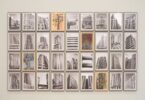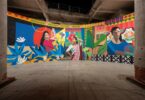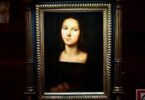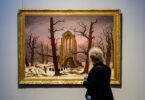Monitoring Desk
CAIRO: Three female-focused paintings welcomed me as I stepped into the downtown Cairo exhibition hall of Mashrabia gallery in December. It was the site of Egyptian artist Omar Abdelzaher’s latest exhibition, “Inspirations from the South” — a profound meditation on life in the south of Egypt, specifically the Nile-side city of Aswan.
The first painting was of a mother putting her child to sleep as they exchange a look, with a crescent moon adorning the upper-right corner of the otherwise thoroughly black background. Next to it was a vibrant painting with a yellow background; a bride carries a hand mirror as two other women treat her to some pre-wedding pampering. The same theme of bridal beauty prep characterized the third painting — of a bride looking into a hand mirror carried by another woman, with a crescent moon in the background.
This painting was of a mother putting her child to sleep as they exchange a look, with a crescent moon adorning the upper-right corner of the otherwise thoroughly black background. (Supplied)
“I like to capture the details of pre-wedding traditions,” Abdelzaher told me as we toured the exhibition, full of other paintings that focus on domestic life and family relations. The aesthetic appeal of the paintings aside, it is the sensitivity with which Abdelzaher paints his female figures and their private worlds that is so striking.
“Many artists who portrayed Aswan in their works — especially male artists like Hussein Bicar, Seif and Adham Wanly — painted Aswan homes from the outside, because they could not gain access to the inner world of these spaces,” says the Cairo-based Aswan-born artist. “Only female artists could set foot in these domestic spaces. Whether it was Tahia Halim, Inji Aflatoun or Gazibiyya Sirri, they were all able to capture the specifics of domestic life in their paintings.”
Abdelzaher adds that his years growing up in Aswan familiarized him with these spaces traditionally reserved for women alone.
Beyond being a sensitive portraiture of domesticity in the southern Egyptian city, the exhibition was also a celebration of Aswan’s vibrant city life.
Thirty-four oil paintings, spanning the years 2013 to 2019, were on display. Together, they “apprise us about Egyptian folklore,” the exhibition statement claimed.
“Expressed by Omar in delightful colors stemming from the local reality, (and) the artist’s passion to document Egyptian folklore and cultural heritage, depicting scenes of people’s life in Egypt (addressing) folkloric symbols, social norms, as well as aspects of men and women in their daily work,” it continued.
“I paint from memory. I will recall an encounter that happened in front of an ice-cream cart some 30 years ago and it will quickly find its way to my next painting,” explained Abdelzaher. “My paintings are attempts to depict the traditions of rural life in Aswan.”
The works on display certainly did that: Street vendors selling their goods, men gathering in an ahwa (Egyptian-style coffee house), and couples in romantic settings, along with agricultural activities including fruit picking and fishing.
Walking around the exhibition truly felt like taking a stroll in Aswan. As we continued our tour, we came across a painting of a woman lying down, with the Nile — and the gorgeous Aswan landscape — behind her. “You could say that this woman represents Aswan,” the artist told me. Abdelzaher sees the Nile — which he refers to as “al-Nil abouna” (Our father, the Nile) — as “part of the daily experience of living in Aswan,” as opposed to Cairo, “where you would actually have to drive to see the Nile.”
Beyond the vivid folkloric aspects of his work, Abdelzaher also incorporates elements of ancient Egyptian pharaonic art into his paintings, reflecting his multiple academic pursuits (he holds an art PhD).
He explained that he sometimes includes the pyramidal composition of ancient paintings, symbols, and other instances of primitive art in his paintings. “Studying and researching everything from ancient art to folktales and fables has certainly elevated my work,” he said.
Courtesy: (arabnews)






